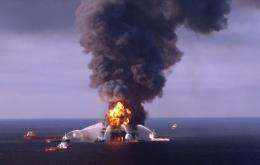BP struggles to cap leak as US oil slick spreads

British oil giant BP used robotic underwater vehicles Monday to try to cap a leaking well and prevent a growing oil slick in the Gulf of Mexico from developing into an environmental disaster.
Satellite images showed the slick had spread by 50 percent in a day to cover an area of 600 square miles (1,550 square kilometers), although officials said some 97 percent of the pollution was just a thin veneer on the sea's surface.
BP has dispatched skimming vessels to mop up the oil leaking from the debris of the Deepwater Horizon rig, which sank on Thursday, two days after a massive explosion left 11 workers missing and presumed dead.
The company said at least four underwater robots, similar to scaled-down submarines, are being employed for a first-of-its-kind attempt to stop the leak by plugging up the leaking well.
Doug Suttles, chief operating officer of BP Exploration & Production Suttles told a press conference outside New Orleans Sunday that workers will use a "blowout preventer" -- a piece of back-up equipment installed near the wellhead, but which has failed to function properly since the rig went down -- to try to plug the leaks.
"It has not been done before, but we have the world's best experts working to make it happen," said the BP executive, who warned that if the attempt fails, it might take as long as two to three months to staunch the leaking well.
BP said it was trying to activate the giant 450-tonne, 50-foot high machine using remotely operated submersible vehicles. At the same time, it is also preparing to drill relief wells that would permanently shut off the oil flow.
"Essentially, they're trying to put a cork in a bottle of champagne," Richard Metcalf, a mechanical engineer at the pro-industry Mid-Continent Oil & Gas Association told AFP.
BP estimated that the leaks, some 5,000 feet (almost one mile) down on the seabed, emanate from two holes in the riser that connects the wellhead to the sunken rig and are were releasing 1,000 barrels, 42,000 gallons, of oil a day.
The coast guard, which conducted two overflights on Saturday and Sunday to assess the extent of the pollution, described it as a "very serious spill."
Five aircraft and 32 spill response vessels -- skimmers, tugs, barges and recovery boats -- were hoping to resume efforts to mop up the slick after weather delays on Saturday.
So far, the slick is not threatening the coast of Louisiana more than 40 miles away, where it could endanger ecologically fragile wetlands that are a paradise for rare waterfowl and other wildlife.
"In the trajectory analysis we don't see any impact to any shoreline within the next three days," Charlie Henry, scientific support coordinator of the US government's National Oceanic and Atmospheric Administration (NOAA), told journalists.
BP said chemical products had also been poured into the slick to help the dispersal process and more were in stock.
And Steve Benz, head of the independent Marine Spill Response Corporation, said that at BP's request he was mounting the largest response effort in his group's 20-year history and BP officials expressed confidence that they will be able to contain the spill offshore.
Still, environmentalists were sounding an alarm about the possible threat to Louisiana's fragile wildlife, and experts said the spill has the potential to be the worst seen in the United States since the 1989 Exxon Valdez oil tanker spill, considered one of the worst man-made environmental disasters.
That spill poured nearly 11 million gallons of crude into Alaska's Prince William Sound, devastating some 750 miles of its once pristine shores.
Meanwhile, there was still no news of the 11 missing Horizon crew members.
The US coast guard, which helped evacuate another 115 to safety after Tuesday's spectacular blast, which shot balls of flame leaping into the night sky, aborted its massive air and sea search on Friday.
Investigations are ongoing into the cause of the accident, which would be the worst in decades on a US offshore platform if the missing men are not found.
(c) 2010 AFP

















